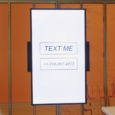Introduction
Stephanie Smith: Hello, I’m Stephanie Smith, Chief Curator
Amber Esseiva: and I’m Amber Esseiva, Assistant Curator
SS: The ICA has really distinctive architecture, including these galleries on the second floor that come together to form a “V”. That gives us an opportunity to invite two artists to each have an individual exhibition, but then for viewers to be able to compare and contrast the ways that the work relates and doesn’t relate.
AE: Dialogues started initially between Stephanie and I speaking through projects that we really wanted to present here and I had been talking about working with Martine Syms and then Stephanie brought Irena as an artist that she really wanted to work with and it just so happens that they had a lot of connections in the way that they produce work that kind of unfolded over time.
SS: Both of them have very distinctive practices. They’re quite different as artists, but yet they share concerns with what it means to be moving through digital culture, questions around entrepreneurship and really rethinking what it means to live in the world right now.
AE: Martine is, for this project, dependent on technology. One is urged to use your cellphone while engaging with the work by texting the work, whereas Ika is interested in an engagement that is much slower, one between human and object that is quite different.
SS: They’re both recognizing the compelling nature of contemporary digital experience and the speed of that, but one is embracing it and the other is really trying to sidestep it and slow us down.
Functional Structures
Stephanie Smith: Another point of connection between these two artist’s practices is that they’re both research driven. They go really deep into the subjects that they are investigating. In both cases they’re not just representing the topic that they’re engaged with, they’re actually creating that thing.
Martine is coding her chatbot, right? She’s not making work about digital culture, she’s actually creating digital culture. Ika is not only making a work about corporate practices, but she actually founded a corporation as a living artwork.
I think in some ways both of them are really functioning a bit as viruses, a kind of infection that can happen and stay with us.
Amber Esseiva: I think it’s the result of two projects that are creating actual structures for us to work into and not just kind of artificial proposals.
You can’t really stop it because it’s not just artifice, you know, it’s a system that continues to work because it’s a working system. So, you can continue to chat with the chatbot, Teenie, when you leave the space. Your engagement with the films when you do that changes, but you can continue to speak to her because she’s a functioning entity. And yes, the goods then move into the world in a way that is actually functional.
SS: And so it felt like there was really rich opportunity for us to bring two artists who had parallel research practices and equally multivalent way of carrying their research out into really exciting forms in the world.

 Closed
Closed
 Closed
Closed

 Area Map
Area Map  Parking
Parking 
